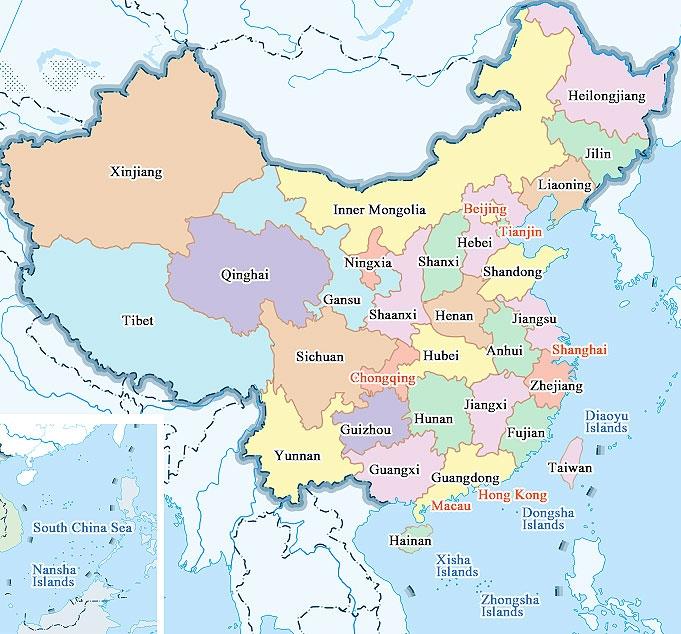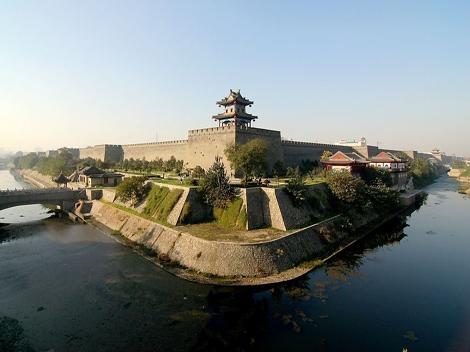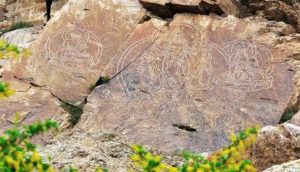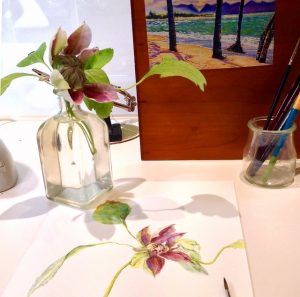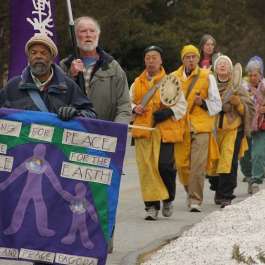
The story of early Chinese Buddhism is often considered as beginning with the arrival of the monk Kumarajiva (334–413), whose translation of Buddhist scriptures from Sanskrit into fluent classical Chinese first enabled the Buddha-Dharma, the teachings of the Buddha, to be revealed to the Chinese people. Yet living in his shadow was a venerable Chinese monk, Dao’an (道安; 312–85), whose lifework was extraordinary in its breadth and contribution, but all the more remarkable for the chaotic times in which he lived.
Dao’an lived during the long period of unrest known as the “Era of the Sixteen Kingdoms of the Five Barbarian States,” when, after 316, the Chinese government abandoned northern China and fled south, establishing the Eastern Jin dynasty (317–420) at Jiankang, near the site of modern Nanjing. The Xiongnu (Huns) took the northern capitals of Luoyang and Chang’an (today’s Xi’an), but the competing clans of Jie and Shi vied for power internally while fighting external threats, forming successive states of Zhao until their downfall in 351. For almost four decades, their severe treatment of the Chinese populace resulted in a breakdown of local economies and society, displacement, poverty, and famine. Those in the adjacent provinces of Shanxi and Hebei fled to the protected valleys within the Taihang mountain range running north and south and forming the border between the two.
Dao’an’s life
Dao’an was born into a family of scholars in Hebei, in the year that Emperor Huai of the Western Jin (265–316) was executed by the Xiongnu. Losing his parents in his youth, he was placed in the care of his maternal uncle, who later schooled him in the Chinese classics and in the works of Laozi and Zhuangzi. Together with his uncle, he took refuge in the Taihang range, which would shelter him for much of his life until he reached his 50s. He took the tonsure there as a Buddhist monk at 18 in 329.
Although he was born into a family of scholars, Dao’an did not have an intelligent bearing; his skin was dark, and from birth, he was marked with a black patch on his left arm. However, these disguised his remarkable gifts. His powers of concentration and memorization and his analytical skills were combined with a deep need to understand the Buddha-Dharma. Despite his appearance, he was recognized for his focus on interpreting the Dharma through analysis of the scriptures, and these efforts made him a natural leader in scholarship and later, a leader of monastic communities, often in circumstances of insecurity and hunger.
The guidance in the Dharma that the young Dao’an received left him with many unanswered questions that made penetrating the meaning of the scriptures difficult, and so at the age of 25, he left the mountains to become a disciple of Fotudeng (c. 232–348), a monk of venerable age from Khotan in Central Asia, in Zhong Si (Central Temple) in the new capital, Ye (Yechang; today’s Anyang, in Hebei), in the relative stability of the Later Zhao State. The old monk’s iron discipline, conduct, adherence to the Vinaya (rules of conduct for monks), and teaching of meditation greatly impressed Dao’an, since these were qualities that Chinese monks often lacked.
After 12 years, in 348, as the Later Zhao State destabilized, he returned at the age of 37 to the mountains, going first to Huoze (in southeast Shanxi), where he met foreign and Chinese monks fleeing Luoyang who brought their own teachings and many sutras in translation that Dao’an read, copied, and annotated. In his early 40s, he set up his own monastic community further north at Heng Shan (southeast of Yingxian, Shanxi). The discipline and training he provided there, his scholarship, and his propagation of Buddhism gave Dao’an a reputation as the most prominent Buddhist leader in northern China, and this attracted many disciples, but also the attention of local power-brokers, forcing him in 365 to move his monastic community south to Xiangyang in Hubei Province under the protection of the Eastern Jin army, who were striving to retake the north. Here, and at Jingzhou, he established two monastic communities that would become centers for the propagation of Buddhism. With no full translation of the Vinaya, Dao’an devised his own systematic code of conduct and religious practice in the monastic community he had formed previously at Heng Shan and then in Hubei, which became models for such communties in the future.
Dao’an was also the founder of the monastic practice of addressing all monks by the Buddha’s name, “Shi” (釋; the first syllable of the name “Shakyamuni” in Chinese), so that any trace of prejudice from ethnicity or social standing would be eradicated, and was also the first to define a uniform dress code for monastics, which has endured. The 12 years he spent at Xiangyang were the most settled, secure, and productive time of his life, not only in terms of monastic organization and propagation, but also in regard to scholarship.
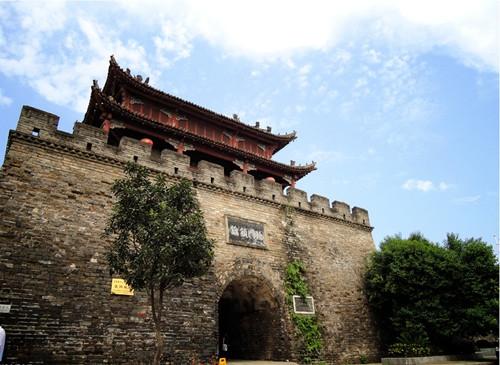
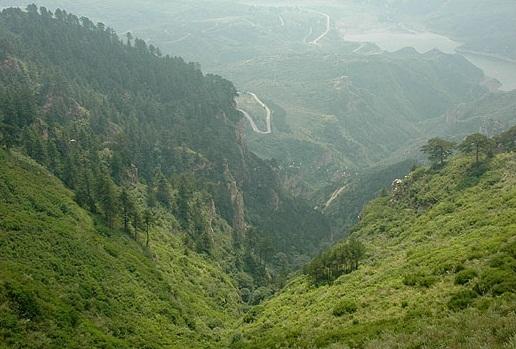
Buddhism in China in the 4th century
Since the time of the Eastern Han dynasty (25–220), sutras, shastras (treatises based on the sutras), and the Vinaya had come through to Chang’an and Luoyang, where they were translated into Chinese by foreign monks working with Daoist and Confucian scholars; neither fully understood the others’ language, and Buddhist concepts were inevitably transcribed into the scholars’ own, familiar Chinese (Daoist) religious framework. The scriptures chosen for translation were on dhyana (meditation) and the prajnaparamita (Perfection of Wisdom), since these seemed closest to Daoist practice, while those on the Vinaya were less popular. Further, there was a mixture of texts from both the southern Indian tradition (Sarvastivadin) and the northern one (Mahayana). The distinction between them and their different approaches to the Dharma were not realized by the Chinese, and at times, their content seemed contradictory.
By the 4th century, these scriptures in translation had been copied, recopied, and passed among the budding Chinese monastic communities. There were consequently copy errors, partial translations, missing pages, different or no titles, and no mention of when they were translated, or by whom. Struggling to understand the Dharma with these issues, the practice of interpreting the terminology by referencing the philosophy of the Daoist masters Laozi and Zhuangzi, called keyi (“matching of terms”), made the Dharma in these scriptures more accessible.

Dao’an and the Dharma
Dao’an’s approach to interpreting the Dharma changed as his understanding of the problems of translating scriptures increased and his appreciation of the true Dharma deepened through his experience with Fotudeng and other foreign monks. At first, the young Dao’an’s orderly mind took an analytical approach, noting concepts throughout each scripture and then comparing their seeming contradictions to arrive at a closer interpretation of the meaning through his understanding of the classics and Daoism. This allowed him to reach a provisional understanding, and his explanations of the Dharma and annotations to Buddhist scriptures attracted fellow monks to study with him. Gradually, though, he became dissatisfied with the use of keyi, particularly when applied to the prajnaparamita sutras—those that explained reality in terms of the Perfection of Wisdom, through the realization of the emptiness of all phenomena. These sutras attracted the intellectuals of Chinese society, who interpreted them in terms of the Daoist “dark learning” that obscured their true meaning.
Dao’an obtained good translations of these and, working with foreign monks, explored their true sense in order to find more correct words in Chinese. His analysis of the concepts in these sutras and exploration of their meaning allowed him to move beyond the restrictions of Daoist terminology. In his examination of the Indic languages in which the scriptures were written, he identified the “Five Lessons and the Three Difficulties” that presented challenges to translation. He wrote prolifically througout his life, annotating and writing commentaries and prefaces to scriptures to aid Chinese monks in the interpretation of the Dharma. His resolve to collect and catalogue all Buddhist scriptures in circulation since the Han dynasty (206 BCE—220 CE), a lifetime’s work, was largely finished in Xiangyang. This was the precursor of the first Chinese Tripitaka (catalogue of scriptures) and a valuable record of the scriptures available at that time.
Dao’an in Chang’an
In 379, Dao’an’s settled stay in Xiangyang ended when Fu Jian of the Former Qin State, who was of Tibetan origin, took Xiangyang as he extended his power eastward from his capital at Chang’an. Dao’an’s fame ensured that Fu Jian would take him to the capital, the terminus for the Silk Route through which foreign monks and scriptures arrived. Here Dao’an spent the final seven years of his life, managing a monastic community and acting as an advisor to Fu Jian and the court while continuing to write. Now in his 70s, he was confronted with many new scriptures arriving in the city that were of the Southern Buddhist tradition (Sarvastivadin), and he set about engaging both foreign and Chinese monks in order to translate them. These new works greatly excited him, but his failing health meant that he could only oversee their translation. The power of the Former Qin State collapsed after 383, and Dao’an and his bureau worked on amid siege and starvation in the city until his death in 385.
Only 15 years separated his death from the arrival of Kumarajiva in Chang’an, where Dao’an’s translation bureau was still working. This Central Asian monk, who would live only another few years, had a transformative effect on Chinese Buddhism that would have been more difficult without Dao’an’s translation bureau and his reforms of the monastic community.
See more
Chinese History – Former Zhao Dynasty
Chinese History – Later Zhao and Ran-Wei Dynasties
Chinese History – Former Qin Dynasty
References
Ch’en, Kenneth. 1964. Buddhism in China. Princeton University Press.
Link, Arthur E. 1958. “Biography of Shih Tao-an.” T’oung Pao, Second Series 46 (1/2): 1-48. http://www.jstor.org/stable/20185466
Mizuno, Kogen. 1982. Buddhist Sutras: Origin, Development, Transmission. Tokyo: Kosei.
Tsukamoto, Zenryu. 1985. A History of Early Chinese Buddhism. Tokyo: Kodansha International.
Richard Story is the co-founder of Dharma Drum Mountain Buddhist Association, London.


